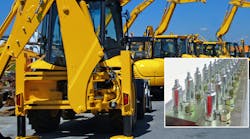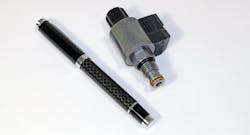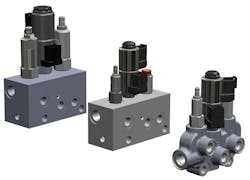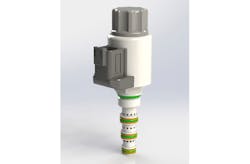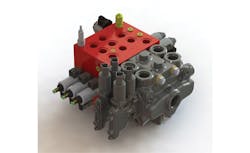Download this article as a .PDF
Screw-in hydraulic cartridge valves were pioneered in the 1970s and quickly adopted by many major manufacturers. Cartridge valves have become popular because they allow quick design of customized hydraulic circuits using a machined manifold block. Manifold blocks can range from two valves to 50 or more and are easily manufactured with little investment using standard equipment and tooling.
The proliferation of manufacturers in the early days led to a variety of cavity configurations often unique to each valve manufacturer. Today, cartridge valve styles fall into three major categories—the common-cavity valve, the floating valve cavity, and the metric-cavity valve, which is prevalent in Europe. Cartridge valves now encompass a vast array of functions with broad flow and pressure capabilities and continue to develop along with ever more affordable and advanced electronic controls.
In reality, the common-cavity valve is far from common. Although the mounting dimensions of the valves adhere to strict guidelines (notably ISO/TR 17209), subtle variations in features are almost endless from one manufacturer to another. The metric cavity system preferred by many European manufacturers is governed by ISO 7789. However, both of these standards have limited scope, covering only 2-, 3-, and 4-port valves within defined size ranges. Many manufacturers offer products that go beyond these standards.
Having a common cavity gives designers greater flexibility by letting them select products from multiple manufacturers that will easily interchange. However, because of the variations, it’s always best to verify that parts are truly interchangeable. For example, a manifold designed for one brand of solenoid valves may not have sufficient clearance between parts when using a different brand because standards do not address coil sizes.
Space on mobile equipment is often hard to find with manufacturers squeezing ever more content onto their equipment. With all the added features and componentry, weight is often also an issue, particularly if it degrades a machine’s operating capacity. Recently, HYDAC developed a line of miniature screw-in cartridge valves following the principles of the common-cavity system. This line was developed to address the growing needs for smaller, lighter products without compromising performance.
This miniature valve line is nominally size 06, whereas the smallest common cavity is size 08. Access to a valve line that accommodates flows less than 5 gpm at working pressure to 5,000 psi is beneficial to equipment manufacturers as they look to improve performance and efficiency while conserving space and money.
A Sense of Balance
Counterbalance valves are critical for safety and must be able to operate smoothly, close quickly, and prevent movement. Nowhere is this more critical than with aerial work platforms, where weight poses a special challenge for designers. That’s because designers want the hydraulic valves close to the actuators to maximize safety and controllability while operators work high above the ground. But doing so can limit load capacity because every pound of hydraulics installed on the lift reduces load capacity by a pound.
By specifying size 06 counterbalance valves and size 06 proportional solenoid valves, the hydraulic system becomes much smaller and 50% lighter than would have been possible using even the smallest common-cavity valve. The small size and light weight of the assembly allows mounting the manifold within the upper structure for optimal installation, plumbing, and performance.
A Compact Quick-Change Act
Another application that can benefit from size 06 cartridge valves is the ability to quickly and easily couple and uncouple different attachments, excavators, front loaders, and other versatile equipment. The environment for attachment manifolds can be quite severe, often operating at high pressures in dirty, corrosive environments in a wide variety of weather extremes.
The small size and light weight of size 06 valves makes them well-suited for use in coupler circuits at hydraulic pressures to 5,000 psi while withstanding shock and vibration. A simple coupler manifold using size 08 may be too large to mount in the space available. Using size 06 valves can reduce the space envelope by 25% and cut the weight in half.
Custom solutions can produce even greater benefits. For example, a cast body design provides the ultimate in reducing weight and raw material usage. Plus, incorporating proprietary multi-function valves takes compact design a step further by reducing the number of valves needed to accomplish circuit functions. For example, HYDAC’s WKDRM series valves incorporate directional and pressure controls in one cartridge to save space and provide failsafe proportional pressure control and additional safeguards.
Other Considerations
Today’s advanced CAD tools and manifold software allow engineers to design complex manifolds without wasting space or sacrificing machine efficiency. However, a well-designed hydraulic integrated circuit is of little value to a machine operator if a valve’s solenoid coil fails. It’s no surprise that OEMs pay close attention to coil qualifications. Many have stringent approval requirements to ensure, for example, that solenoid coils can survive high vibration, thermal shock, overvoltage, etc.
The increased use of proportional directional-control valves brings with it the need to maintain clean hydraulic fluid. It’s estimated that 70% of all hydraulic equipment breakdowns can be attributed to contaminated hydraulic fluid. Incorporating pressure and return filters into a manifold further extends the advantages of an integrated hydraulic circuit—more compact design and fewer potential leak points.
Sometimes a misconception exists that cartridge valves and manifolds must be stand-alone subassemblies. This need not be the case because manifolds can be designed to also incorporate other types of valves, such as monoblock or sectional valves, which are widely used in mobile equipment. The valves work together with proportional pilot modules for precise spool control and save space by replacing a lower flow function.
Using a manifold-sectional valve assembly helped one OEM overcome installation challenges by reducing the space envelope by more than 50%. Size 06 valves in a manifold have replaced six individual sections and reduced the envelope more than half. Using an aluminum manifold to replace six cast iron sections proved less expensive and reduced weight to a fraction of what it was originally. Simplified installation also reduces labor and cost.
